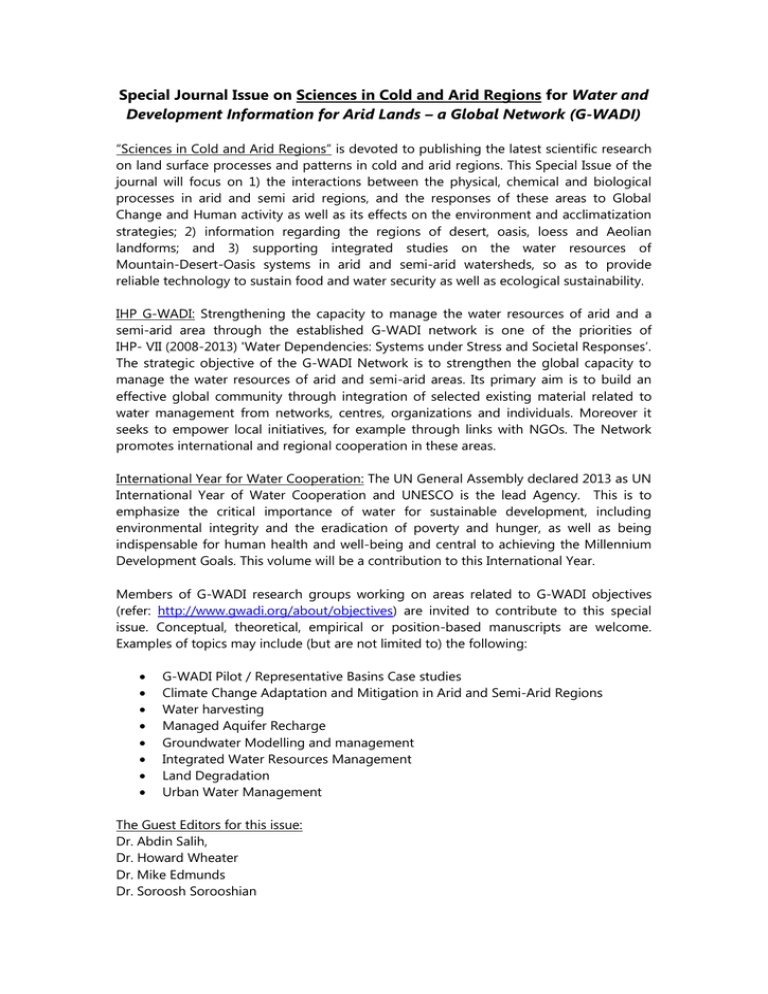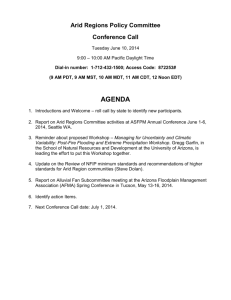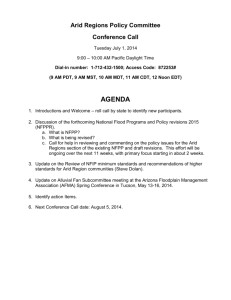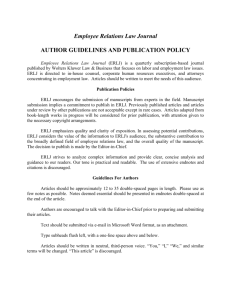Special Journal Issue on Sciences in Cold and Arid Regions for
advertisement

Special Journal Issue on Sciences in Cold and Arid Regions for Water and Development Information for Arid Lands – a Global Network (G-WADI) “Sciences in Cold and Arid Regions” is devoted to publishing the latest scientific research on land surface processes and patterns in cold and arid regions. This Special Issue of the journal will focus on 1) the interactions between the physical, chemical and biological processes in arid and semi arid regions, and the responses of these areas to Global Change and Human activity as well as its effects on the environment and acclimatization strategies; 2) information regarding the regions of desert, oasis, loess and Aeolian landforms; and 3) supporting integrated studies on the water resources of Mountain-Desert-Oasis systems in arid and semi-arid watersheds, so as to provide reliable technology to sustain food and water security as well as ecological sustainability. IHP G-WADI: Strengthening the capacity to manage the water resources of arid and a semi-arid area through the established G-WADI network is one of the priorities of IHP- VII (2008-2013) 'Water Dependencies: Systems under Stress and Societal Responses’. The strategic objective of the G-WADI Network is to strengthen the global capacity to manage the water resources of arid and semi-arid areas. Its primary aim is to build an effective global community through integration of selected existing material related to water management from networks, centres, organizations and individuals. Moreover it seeks to empower local initiatives, for example through links with NGOs. The Network promotes international and regional cooperation in these areas. International Year for Water Cooperation: The UN General Assembly declared 2013 as UN International Year of Water Cooperation and UNESCO is the lead Agency. This is to emphasize the critical importance of water for sustainable development, including environmental integrity and the eradication of poverty and hunger, as well as being indispensable for human health and well-being and central to achieving the Millennium Development Goals. This volume will be a contribution to this International Year. Members of G-WADI research groups working on areas related to G-WADI objectives (refer: http://www.gwadi.org/about/objectives) are invited to contribute to this special issue. Conceptual, theoretical, empirical or position-based manuscripts are welcome. Examples of topics may include (but are not limited to) the following: G-WADI Pilot / Representative Basins Case studies Climate Change Adaptation and Mitigation in Arid and Semi-Arid Regions Water harvesting Managed Aquifer Recharge Groundwater Modelling and management Integrated Water Resources Management Land Degradation Urban Water Management The Guest Editors for this issue: Dr. Abdin Salih, Dr. Howard Wheater Dr. Mike Edmunds Dr. Soroosh Sorooshian Dr. Will Logan Dr. Wouter Buytaert Dr. Li Xin Dr. Zhoutong Nan Dr. Shakeel Ahmed Dr. Ramakar Jha Dr. Waleed K AlZubari Dr. Abdou Ali Dr. Cheikh Becaye Gaye Dr. Guido Saito Dr. Koen Verbist Dr. (Ms) Sedigheh Torabi-Palatkalahe Dr. Siegfried Demuth Dr. Anil Mishra Dr. R. Jayakumar Mr. Cameron Munro Mr. Giuseppe Arduino Ms. Niloofar Sadeghi, Dr. Simon Sargsyan Dr. Abou Amani Dr. Alexandros K. Makarigakis Dr. Abdel Aziz ZAKI Ms. Zelmira May Information for potential authors 25 articles will be selected to be included in the Special Issue of this Journal Articles will be published in the 1st Issue of 2013 (Journal is bimonthly) No set page limit to article length There will be no publishing charges as these will be paid by CAREERI. However, SCAR does not pay any royalty to authors Color figures are allowed at no additional charge Authors will receive both an electronic copy as well as a hard copy of the issue Please ensure originality, papers already published cannot be published on SCAR IHP and G-WADI logos shall appear on the face cover of that issue Journal already submitted for the “Institute for Scientific Information” ISI Citation index, before the publication of the journal may also get approval Deadlines: Submission of full length paper for review 31 July 2012 Comments from review panel 31 August 2012 Final version copy 30 September 2012 Papers will appear in Volume 5 Issue 1 February 2013 The final papers should be sent to: r.jayakumar@unesco.org and a.mishra@unesco.org GUIDE TO AUTHOR Sciences in Cold and Arid Regions has no page charges. Manuscript Submission: Sciences in Cold and Arid Regions operates an online submission and peer review system that allows authors to submit articles online and track their progress via a web interface. To submit a manuscript, please visit http://www.SCAR.ac.cn/ to log on, get an account, and follow the instructions to upload the paper files (in Word format). The signed Copyright Transfer Form (Download on home page)should be scanned and uploaded as "Supplementary files not for review" with the online submission of your article. Alternatively, the signed Copyright Transfer Form can be sent immediately following the online submission of your article to: Liangying Sun (Technical editor), Cold and Arid Regions Environmental and Engineering Research Institute, CAS. No. 320 Donggang West Road, Lanzhou, Gansu 730000, China. (Email: SCAR@lzb.ac.cn) Authors are encouraged to suggest the names and full contact details of potential referees on the understanding that the Editor has the final decision on the selection of referees. Submission of a manuscript will be held to imply that it contains original unpublished work and is not being submitted for publication elsewhere at the same time. 1. Contributions published in Sciences in Cold and Arid Regions: Review: authoritative and foresighted articles that review the present research status, progress and problems of active, rapidly developing research fields, and suggest insightful concepts for future study; or summarize the representative achievements of a certain important field, findings, progresses and problems in the emerging research fields and make suggestions for future work. Research articles: report innovative, systematic and integrated study results. Brief express: report prominently innovative investigation with great academic significance. Text comprises only a heading (no subhead) and a brief abstract, totaling less than 3000 words (two page spaces). The full text of final investigation results can still be published in "Research articles" of this Journal. Forum or news: introduce and comment on quality monographs of natural sciences, discuss and make reply to the contributions published in Sciences in Cold and Arid Regions, or introduce and comment on a controversial issue of general interest; report important scientific news, information, and academic affairs, as well as the outcomes of significant international conferences (800 words). 2. Manuscript composition (in the order given) 2.1) Title: Concise and informative title is often used in information-retrieval systems, so it is suggested avoiding abbreviations and formulae where possible. 2.2) Author names and affiliations: Please give full name details for all authors who are responsible for the paper’s gist and data, cited with given name before family name (e.g., YaFeng Shi, James S. Gardner). Where the family name may be ambiguous (e.g., a double name), please connect them with hyphen. Present the authors’ affiliation addresses (where the actual work was done) below the names. Indicate all affiliations with a lowercase superscript letter immediately after the author’s name. Provide the full postal address of each affiliation, including the country name, and the permanent e-mail address of the correspondence author (who is willing to handle correspondence at all stages of refereeing and publication, also post-publication). 2.3) Abstract: Abstracts should state briefly the purpose and method of the study, the principal results and major conclusions. An abstract is often presented separate from the article, so references, non-standard or uncommon abbreviations should be avoided 2.4) Keywords: Immediately after the abstract, provide a maximum of 6 keywords, avoiding general and plural terms and multiple concepts (avoid, for example, 'and', 'of'). 2.5) Introduction: State the objectives, the method of the work and provide an adequate background, avoiding a detailed literature survey or a summary of the results. 2.6) Materials and methods: Provide sufficient detail to allow the work to be reproduced. Methods already published should be indicated by a reference. 2.7) Discussion and Conclusions: Please relate your findings to past and current published work, indicating the significance of your contribution, with its limitations, advantages and possible applications. 2.8) Acknowledgements: Acknowledgements include information on grants received, and if applicable, the information regarding fund. 2.9) References: Please ensure that every reference cited in the text is also present in the reference list (and vice versa). Unpublished results and personal communications should not be in the reference list, but may be mentioned in the text. In text, references are cited as "Pegan, 2006" for single author, as "Osterkamp and Romanovsky, 1999" for two, and as "Bhandarkar et al., 2006" for three or more authors. Citations may be made directly (or parenthetically). Groups of references should be listed first chronologically, then alphabetically. In the reference list, references should be arranged first alphabetically and then further sorted chronologically if necessary. More than one reference from the same author(s) in the same year must be identified by the letters "a", "b", "c", etc., placed after the year of publication. Journal names should not be abbreviated. Examples: Reference to a journal publication: Frank A, Kocurek G, 1996. Toward a model for airflow on the lee side of aeolian dunes. Sedimentology, 43(3): 451–458. Reference to a book: Cooke RU, Warren A, Goudie A, 1993. Desert Geomorphology, Second edition. UCL Press, London. Reference to a chapter (or a paper) in an edited book(or a proceeding): Brouwer R, Dewit CT, 1969. A simulation model of plant growth with special attention to root growth and its consequences. In: Whittington WJ (eds.). Root Growth. Butterworth, London. 224–244. 3. Manuscripts format 3.1) Please write your text in good English (American or British usage is accepted, but not a mixture of these) and save as .doc format. The manuscripts should be organized in a 10 pt Times New Roman font with 1 line spacing. The text, tables and figures must be in one document. Please read the sample: The sample of manuscript.doc (Download on home page) 3.2) Tables and Figures or Photographs must be numbered consecutively with Arabic numerals respectively and should be placed in their corresponding places in the text. Tables should be concise and exact and should use three-lines. Photographs should be of sufficiently high quality with respect to detail and contrast, indicated the magnification by a bar on the photograph. It is recommended that drawings are processed with Excel or CorelDraw or are readable and editable in CorelDraw; Photographs (or combined with drawings) should be highresolution (over 600 dpi) files readable and editable in Adobe Photoshop. Their widths are given alternatively in 80mm (half column), 160mm (single column), 160mm× 240mm (including figure caption). The lettering and symbols, as well as other details Figures are not larger than 8 pt Times New Roman font. 4. Reviewing, revision and acceptance of manuscripts Every manuscript is independently reviewed by peers. If two or more reviewers consider the manuscript unsuitable for publication in this journal, a statement for the decision will be sent to authors within one or two months of the submitting date. A manuscript sent back to corresponding author for revision should be returned to the editor without delay. One to two months before the manuscript is published, a press proof in ".pdf" format will be emailed to authors. Authors check and approve the press proof, then upload or email back in 3 days. 5. Publishing Once the article is published in this journal, beside electronic copy, each author shall receive a hard-copy of that issue at free of cost






